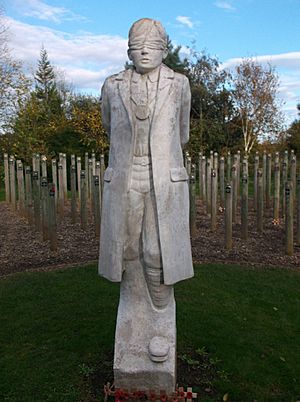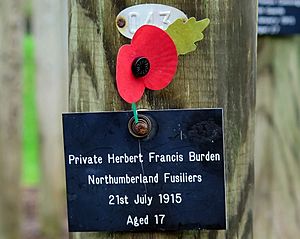Shot at Dawn Memorial facts for kids

The memorial in 2014
|
|
| Coordinates | 52°43′29″N 1°43′28″W / 52.7248°N 1.7244°W |
|---|---|
| Location | National Memorial Arboretum, Staffordshire, United Kingdom |
| Designer | Andy DeComyn |
| Type | Sculpture |
| Material | Sculpted concrete statue, surrounded by 306 wooden stakes |
| Completion date | 2001 |
| Opening date | 21 June 2001 |
| Dedicated to | The servicemen executed by firing squad during World War I |
The Shot at Dawn Memorial is a special monument in the National Memorial Arboretum. This arboretum is a place where people remember those who served their country. The memorial is located near Alrewas in Staffordshire, UK. It honors 306 soldiers from the British Army and other Commonwealth countries. These soldiers were executed during World War I after being found guilty of serious offenses.
Contents
Remembering Soldiers: Why This Memorial Exists
This memorial remembers soldiers who were executed by firing squad during World War I. Many people believe these soldiers did not always get fair trials. Some were very young, and others might have been suffering from extreme stress. This stress is now known as post-traumatic stress syndrome. It is a serious condition that affects people after very difficult experiences.
During the war, commanders had a tough job. They needed to keep their armies fighting. Decisions about executions were made in very difficult times.
About 200,000 soldiers faced military trials during World War I. Around 20,000 were found guilty of offenses that could lead to the death penalty. Out of these, 346 executions actually happened. The others received lighter punishments.
Families of these soldiers often felt ashamed. They were sometimes labeled as having a "coward" in their family. Also, the soldiers who had to be part of the firing squads often suffered emotional pain.
For a long time, Britain did not pardon these soldiers. In 1993, John Major, who was Prime Minister, said that pardoning them would disrespect those who died bravely. However, in 2006, Des Browne, the Defence Secretary, changed this decision. He said that injustices clearly happened in some cases. He believed all these men were victims of the war. In 2007, a law was passed to officially pardon these soldiers after their deaths.
The Memorial's Design and Meaning
The artist Andy DeComyn created this memorial. He made it in 2000 as a gift to the families of the soldiers. It was officially shown to the public in June 2001. Gertrude Harris, whose father was one of the soldiers, helped unveil it.
The memorial shows a young British soldier. He is blindfolded and tied to a stake. This represents how soldiers were executed by a firing squad. The soldier's face on the statue looks like Private Herbert Burden. He was only 17 when he joined the army. He lied about his age to enlist. He was later executed for leaving his post.
A semicircle of wooden stakes surrounds the statue. Each stake has the names of the soldiers who were executed in this way. There are 306 stakes, one for each soldier.
Soldiers by Nationality
This table shows where the soldiers who were executed came from.
| Nationality | Number |
|---|---|
| United Kingdom | 291 |
| Canada | 25 |
| New Zealand | 5 |
| British West Indies | 4 |
| Australia | 0 |
| Civilians subject to military law (inc. Chinese labour) |
21 |
Soldiers by War Location
This table shows where the executions happened during the war.
| Location | Number |
|---|---|
| France & Belgium | 322 |
| East Africa | 5 |
| Mesopotamia | 4 |
| Constantinople | 4 |
| Gallipoli | 3 |
| Salonika | 3 |
| Egypt | 2 |
| Italy | 1 |
| Palestine | 1 |
| Serbia | 1 |
Reasons for Execution
This table lists the main reasons these soldiers were executed.
| Reason | Number |
|---|---|
| Desertion | 266 |
| Murder | 37 |
| Cowardice | 18 |
| Quitting a post without authority | 7 |
| Striking or using violence to a superior officer | 6 |
| Disobedience to a lawful command | 5 |
| Mutiny | 3 |
| Sleeping at post | 2 |
| Casting away arms | 2 |


